Advertisement

Muons: The Subatomic Particles Shaking Up the World of Physics
- Share Content on Facebook
- Share Content on LinkedIn
- Share Content on Flipboard
- Share Content on Reddit
- Share Content via Email

Key Takeaways
- Muons are elementary particles similar to electrons but with greater mass.
- They are created naturally in cosmic rays and play a crucial role in particle physics experiments.
- Muons have unique properties that make them useful for studying fundamental physics concepts.
What is about 200 times the mass of an electron, exists for about 2-millionths of a second, continually strikes every inch of Earth's surface, and seems to behave in a way that pokes a hole in long-accepted laws of physics?
That would be the muon, a particle first discovered in the late 1930s , which is formed in nature when cosmic rays strike particles in our planet's atmosphere. Muons are passing through you and everything around you at a speed close to that of light. Nevertheless, many of us probably didn't even realize their existence until April 2021, when the particle made the news headlines after researchers at the U.S. government's Fermi National Accelerator Laboratory — more commonly known as Fermilab — released the initial results of a three-year-long Muon g-2 experiment .
The Fermilab study confirmed previous findings that the muon behaves in a way that's contrary to the Standard Model of Particle Physics , the theoretical framework that aims to describe how reality works at the tiniest level. As this article in Science explains, muons — which exist in a sea of other tiny particles and antiparticles that affect them — actually are slightly more magnetic than the Standard Model would predict. That, in turn, points to the possible existence of other, still-unknown particles or forces.
As one of the researchers, physicist Jason Bono, explained in a news release from his alma mater Florida International University, the team knew that if they confirmed the discrepancy in muons' magnetism, "we wouldn't know exactly what's causing it, but we would know it's something that we don't understand yet."
The initial results, along with other recent particle research , could help build the case for a new physics that would replace the Standard Model. From Fermilab, here's a YouTube video explaining the results and their significance:
"Muons are like electrons except 200 times heavier," explains Mark B. Wise , in an email interview. He's a professor of high energy physics at the California Institute of Technology and a member of the prestigious National Academy of Sciences . (If that doesn't sufficiently impress you, he also served as a technical consultant on particle accelerators for the 2010 Hollywood film "Iron Man 2").
"According to Einstein's formula E=mc2, this means that muons at rest have greater energy than electrons," Wise says. "This allows them to decay to lighter particles while still conserving energy overall."
Another key difference is that electrons are believed to be pretty close to immortal , but muons only exist for 2.2 millionths of a second, before they decay into an electron and two kinds of neutrinos, according to this U.S. Department of Energy primer on the particle.
The muons that are constantly being created when cosmic rays strike particles in Earth's atmosphere travel astonishing distances in their brief existence, moving at close to the speed of light. They strike every inch of Earth's surface and pass through almost everything in their immediate path, potentially penetrating a mile or more into Earth's surface, according to DOE.

Some have described muons as the key to understanding all subatomic particles, though Wise doesn't go quite that far. "In the search for physics beyond our present understanding you should study all particles," he says. "The muon has some advantages though. For example its anomalous magnetic moment is very precisely predicted which makes it more sensitive to new physics, beyond our present theory that would alter this prediction. At the same time it can be measured very precisely."
Studying muons isn't a simple matter, though. Fermilab is using a 700-ton (635 metric ton) device containing three rings, each 50 feet (15 meters) in diameter, that was shipped by barge and truck to Illinois from its original home at Brookhaven National Laboratory in New York a few years back. The device is capable of generating a magnetic field of 1.45 Tesla, approximately 30,000 times that of Earth's magnetic field.
"It's fascinating that to study something so tiny and short-lived, they need these huge pieces of equipment," Wise explains. "When they are produced at high energy they travel almost at the speed of light and can travel a fair distance before they decay. So you might look for the evidence they leave in a detector."
For example, since muons are charged particles, they can ionize the matter they pass through. The electrons that are produced by this ionization can be detected, according to Wise.

Wise says the Fermilab team's recent discover that the particle is slightly more magnetic than physicists expected is significant. "It disagrees with the present theories prediction for the muon magnetic moment (the present theory is usually called the Standard Model). So there is some new physics beyond that in our present theory that is present and changes the prediction for this quantity," Wise says
Like many important discoveries, the Fermilab's finding raises more new questions, and there's much that scientists still want to know about the muon.
"What is the new physics is the question it raises," Wise says. "There are also some other anomalies that are not explained in the [Standard Model] that involve muons. Are they all connected in some way?"
Wise also sounds a note of caution about the Fermilab findings. "It may be there is some systematic effect in the experiment that is not understood and is impacting the interpretation of the measurement," he explains. "Similarly for the theory. So this anomaly could ultimately disappear. It is very important to check such things as much as is possible."
As Fermilab physicist Chris Polly notes in this 2020 essay, every particle in the universe — even in the deepest, most seemingly empty expanses of space — is surrounded by an "entourage" of other particles, which continually "blink in and out of existence."
Frequently Asked Questions
How are muons detected and measured in scientific experiments, what are some potential applications of muon imaging technology beyond scientific research.
Please copy/paste the following text to properly cite this HowStuffWorks.com article:
Local Navigation
Site Navigation
General Lab Information

Muon g-2 Experiment
How do subatomic muons “wobble” in a magnetic field comparing precision measurements with theoretical calculations provides a stringent test of the standard model of particle physics..
Brookhaven National Laboratory physicists have made important contributions to the study of the anomalous magnetic moment of the muon , commonly known as “muon g-2.” These include running a groundbreaking experiment to make precision measurements of this quantity, transporting a giant muon storage ring to Fermi National Accelerator Laboratory (Fermilab) to continue these experiments at higher precision, and calculating with ever-increasing accuracy the theoretical value of muon g-2. The idea is to test whether the measurements and theoretical predictions match up. Significant deviations between the two would potentially point to “new physics” beyond the Standard Model—scientists’ current understanding of the particles and forces that make up our universe.
What is Muon g-2?
The Muon g-2 experiment measures what happens as muons circulate through a 50-foot-diameter electromagnet storage ring. The muons, which have intrinsic magnetism and spin (sort of like spinning toy tops), start off with their spins aligned with their direction of motion. But as the particles go 'round and 'round the magnet racetrack, they interact with the storage ring’s magnetic field—and also with a zoo of virtual particles that pop in and out of existence within the vacuum. These interactions cause the muon spins to precess, or “wobble” away from their spin-aligned path. Mathematical calculations based on the Standard Model can precisely predict how the muons’ alignment should precess. Sensors surrounding the magnet measure the precession with extreme precision so the physicists can test whether the theory-generated prediction matches up.

Life of a muon: a conceptual diagram of the Muon g-2 experiment
Muon g-2 News
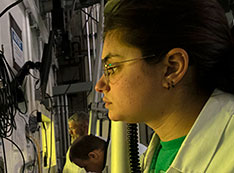
Driving Innovation and Discovery: DOE's Office of Science 2023 Year in Review
Thursday, December 21, 2023
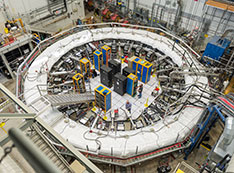
Muon g-2 Doubles Down With Latest Measurement, Explores Uncharted Territory in Search of New Physics
Thursday, August 10, 2023
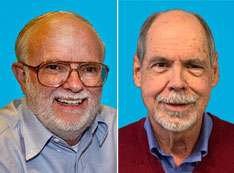
Morse and Roberts Win W.K.H. Panofsky Prize for Muon g-2 Experiment
Tuesday, October 11, 2022
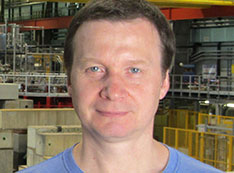
527th Brookhaven Lecture: New Physics, Measuring Muon Magnetism
Tuesday, May 24, 2022
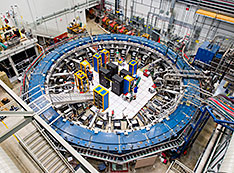
First Results from Fermilab's Muon g-2 Experiment Strengthen Evidence of New Physics
Wednesday, April 7, 2021
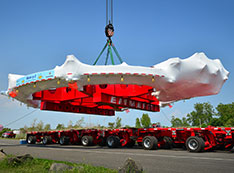
Background on Brookhaven Lab's Involvement in the Muon g-2 Experiment
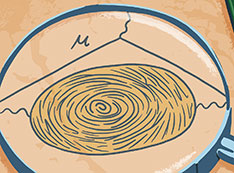
The Mystery of the Muon's Magnetism
Tuesday, March 30, 2021

Just a few of the contributors on the Brookhaven-led muon g-2 research team, circa 2001.

The Brookhaven Muon g-2 experiment
Brookhaven Lab’s Muon g-2 experiment was constructed from 1989 to 1996 and collected data from 1997 to 2001. It used a beam of protons from the Lab’s Alternating Gradient Synchrotron (AGS) to generate the muons used for the experiment. The first analysis of Brookhaven’s results, announced in 2001, revealed that there was poor agreement between the measurement and the Standard Model prediction. Later improvements to the theoretical calculations brought the values closer, but follow-up analyses of Brookhaven’s experimental data confirmed with even higher precision that a discrepancy remained.
February 2001
Physicists Announce Possible Violation of Standard Model of Particle Physics
Scientists at Brookhaven Lab, in collaboration with researchers from 11 institutions in the U.S., Russia, Japan, and Germany, announced an experimental result that directly confronts the Standard Model of particle physics. The Brookhaven finding—a precision measurement of the anomalous magnetic moment of the muon—deviates from the value predicted by the Standard Model.
December 2001
Update on the g-2 Experiment
After the February 2001 announcement by the Brookhaven-led collaboration that a possible "hole" in the Standard Model of particle physics had been detected, a group of theoretical physicists took a closer look at the predicted theoretical value of muon g-2. By reexamining the calculations used to derive this value, theoretical physicists stated that a mathematical error in the calculation of the predicted value for g-2 existed, reducing the difference between the observed and predicted values.
Physicists Announce Latest Muon g-2 Measurement
The Brookhaven-led collaboration reported a new result for the value of the anomalous magnetic moment of the muon, with twice the precision of the earlier result. Physicist Vernon Hughes stated that the “new, higher-precision measurement of muon g-2 provides a unique and unusually sensitive test of the validity of the general theory of electromagnetism or, equivalently of the Standard Model of particle physics."
January 2004
New g-2 Measurement Deviates Further From Standard Model
The latest result from the international collaboration investigating how the muon's spin is affected as it moves through a magnetic field deviates further than previous measurements from theoretical predictions. The result strengthens the challenge the experiment first posed to the Standard Model of particle physics in February 2001, and then backed with a more precise result in July 2002.
Background on the Muon g-2 experiment and glossary
The 'Big Move'
In 2013, physicists, engineers, riggers, and many others teamed up to move the 50-foot electromagnet used to store the circulating muons on a grand land-and-sea voyage from Brookhaven Lab to Fermilab so physicists could run the experiment with a more intense beam of muons.

While most of the machine was disassembled and brought to Fermilab in trucks, the massive electromagnet (shown here leaving the Brookhaven campus) had to be transported in one piece.

To minimize traffic delays, highway land transport occured at night on a truck travelling no more than 10 miles per hour.

The ring reaches its Smith Point Marina departure point on Long Island where it was loaded onto a barge for the ocean portion of its trip to Fermilab in Illinois.
Learn more about Fermilab’s Muon g-2 experiment

Pictured from left to right are g-2 researchers Chulwoo Jung (BNL), Christoph Lehner (BNL), Luchang Jin (RIKEN-BNL & University of Connecticut), and Taku Izubuchi (BNL & RIKEN-BNL).
Theoretical calculations of muon g-2
Muon g-2 theory news.
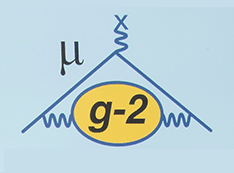
Physicists Publish Worldwide Consensus of Muon Magnetic Moment Calculation
Thursday, June 11, 2020

Theorists Publish Highest-Precision Prediction of Muon Magnetic Anomaly
Friday, July 13, 2018

Sam Krishnamurthy and former Brookhaven Lab postdoc and current Fermilab staff member Jason Crnkovic inside the muon storage ring at Fermilab.
Brookhaven Lab’s ongoing contributions to understanding muon g-2
In 2022, Brookhaven Lab physicist William Morse and Boston University physicist Lee Roberts—who, together with Vernon Hughes of Yale University (deceased in 2003), led the Brookhaven Lab muon g-2 experiment—were awarded the American Physical Society’s 2023 W.K.H. Panofsky Prize . The award recognized their leadership and the experiment’s role in sparking a worldwide search for new physics. Morse has said the most important result was all the young people who became physicists doing “this beautiful physics.” Morse and Brookhaven physicist Vladimir Tishchenko, who joined the experiment just as it was moving to Fermilab, are active members in the ongoing g-2 collaboration. The Fermilab experiment completed collecting data in July 2023. Analysis of the data and work by theorists at Brookhaven Lab and elsewhere on the theoretical calculations used for comparison with and interpretation of the experimental results will continue for some time.
Below: Fermilab’s Tammy Walton in 2018 at the updated g-2 experiment. Walton was honored with Brookhaven Lab’s Leona Woods Distinguished Postdoctoral Lectureship Award . Watch her g-2 talk at Brookhaven Lab.

Brookhaven National Laboratory
PO Box 5000 Upton, NY 11973-5000 (631) 344-8000
- Our Science
- Visiting the Lab
- Staff Directory
- Guest Center
- Partnerships
- For Vendors
- Departments
- Public Events
- Diversity, Equity & Inclusion
- Technology Licensing
- Stakeholder Relations
- Students & Educators
- Sustainability
- Privacy and Security Notice
- Vulnerability Disclosure Program
Brookhaven Science Associates
Brookhaven Science Associates manages and operates Brookhaven National Laboratory on behalf of the U.S. Department of Energy's Office of Science. BSA is a partnership between Battelle and The Research Foundation for the State University of New York on behalf of Stony Brook University. | More

On top of a mountain at 6000 ft a muon detector measures a flux of 550 muons per hour. At a laboratory at the base of the mountain at 2000 ft, a simultaneous experiment measures 422 muons/hr. The half-life of the muon is 1.56 microseconds. How fast were the muons traveling?
The distance traveled L=4000 ft x 0.3048 m/ft = 1219 m
The results of this calculation are:
Considering time dilation, we must take into account that the average lifetime must be transformed by the Lorentz transformation.
The problem with this is that there are two unknowns: we know neither the time nor the average lifetime. However, we can get a reasonable estimate of the average lifetime by assuming that the velocity is essentially =c. We use this assumption to calculate the time of transit.
The historical experiment upon which the model muon experiment is based was performed by Rossi and Hall in 1941. They measured the flux of muons at a location on Mt Washington in New Hampshire at about 2000 m altitude and also at the base of the mountain. They found the ratio of the muon flux was 1.4, whereas the ratio should have been about 22 even if the muons were traveling at the speed of light, using the muon half-life of 1.56 microseconds. When the time dilation relationship was applied, the result could be explained if the muons were traveling at 0.994 c.
In an experiment at CERN by Bailey et al., muons of velocity 0.9994c were found to have a lifetime 29.3 times the laboratory lifetime.
April 7, 2021
Big Physics News: The Muon g-2 Experiment Explained
Particles called muons are behaving weirdly, and that could mean a huge discovery.
By Clara Moskowitz & Jeffery DelViscio
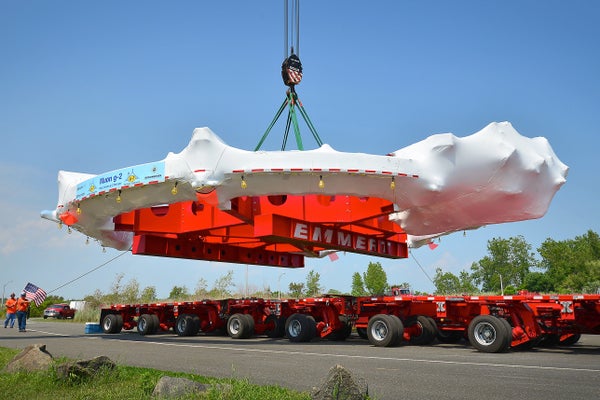
The giant Muon g-2 storage ring before being installed, in 2013.

This is Scientific American ’s 60-Second Science podcast. I’m Clara Moskowitz.
There are probably many more particles out there in the universe than the ones we know about. And today physicists got a hint about where they might be hiding. The finding comes from an experiment at Fermilab called Muon g-2, which looks at particles called muons that are heavier cousins of electrons.
It turns out their spins wobble more than the standard laws of physics say they should. Here to tell us all about it is David Hertzog of the University of Washington , one of the physicists on the experiment. By the way, this segment is on the longer side, dear listener. But hey, this is complicated physics.
On supporting science journalism
If you're enjoying this article, consider supporting our award-winning journalism by subscribing . By purchasing a subscription you are helping to ensure the future of impactful stories about the discoveries and ideas shaping our world today.
David, thanks for being here.
“Thanks, Clara. This is a really exciting time for us.”
Okay. Let’s get grounded. Why are muons important?
“Well, since the discovery of the muon, it’s played, actually, a rather unique and versatile role in subatomic physics. Topics that people use muons for range from fundamental constants of nature, basic symmetries, weak nucleon and nuclear interactions.
“And for us, what we care about the most is standard model tests and searches for new physics. That’s what we’re going to do with them. Now the muon is an unstable particle. It only lives for about two microseconds, but that’s sufficiently long to precisely study its properties. And yet it’s actually sufficiently short so that we have enough decays that we can also study a lot of tremendous information in the decay processes.
“Now, by a quirk of nature, which we call parody nonconservation or space nonconservation, muons are born what we call fully polarized, meaning they have spins in a direction that we go like tops do. And when they decay, we say they are a self-analyzing, which means we can figure out which way they were spinning when they decayed.
“And these two attributes are essential for the experiment that I’m going to talk to you about.”
So tell us why you ran this experiment in the first place. Why look at muon spin?
“Well, when we measure the rate that the muon spin wobbles, or I use the word processes in a magnetic field, we learn directly about its own magnetism, which we call the magnetic moment.
“But you might ask, ‘What do we care about that for?’ Well, the laws of physics actually predict this magnetism very, very precisely. And the laws, if we think we know them completely, in turn, tell us the rate of that wobbling that we should expect in the magnet. So by measuring the rate, we can learn that the laws of physics are missing anything.”
Now tell us about the setup of this experiment in basic terms. How did it work?
“It is a very, very complicated setup, Clara. But let me just try to break it down simply: We shoot big batches of muons into a large 14-meter-diameter superconducting magnet. All of them, we shoot in with their spins, kind of lined up in the direction they’re going like headlights on a car. When the muons begin to circulate and run around the magnetic ring, they sort of act like race cars going around a circular track. So as they go round and around and around. It turns out that the direction that their spins point no longer stays kind of lined up with the way they were when they were injected.
“And every 29 times around the track, the spin direction actually makes an extra full turn. So this difference is what we measure. We measure the difference between the spin direction and the direction the muons were going. That signal, then, is all tied up in the comment I made about parity violation earlier—in self-analyzing spin, I said. We record the products of the muon decays when they spin around like that. And we collect them into a spectrum that ends up with a kind of a modulation exactly at that lapping frequency. So the lapping frequency is the ticket. How fast the spin goes around faster than the muon runs around.”
And what did you find?
“Well, we found that that wobble frequency was faster than the prediction—and we found, also interestingly enough, that the same kind of level faster than what had been measured 20 years ago at Brookhaven National Lab. So we confirmed this, this value that was out there for about 20 years, that people were kind of like ‘Is that right?’”
So what does this mean, and why is it so exciting?
“Oh, it’s truly exciting because the significance of the difference now, between the prediction and the experiments, is so high that it looks like it might be revealing something. Twenty years ago, it was just a soft difference between the prediction, but we have a higher-precision experiment now.
“And when we can bind that with the measurement from 20 years ago, the precision is pretty high. And we’re really at the level where people begin to think this starts to look a bit like a discovery. So at the very beginning, Clara, what you said was perhaps there are more particles in the universe than the ones we know about, and it’s those extra particles which would cause this spin to go faster than the prediction.
“It is such a complicated experiment. We’re publishing four papers at once—probably 100 pages in the journals—to explain the whole thing. I’ve been doing this for about 30 years. So you also realize we do this blinded, right?”
Right. So when did you find out?
“Just about a month ago. So, you know, just enough to put in the numbers into the final plots and to write the beginning and ends of the paper—90 percent of the papers written before we know their result. And basically, you have 170 people sitting on a zoom meeting that all have to be satisfied and vote. And then we reveal these secret envelopes, and then we decode the clock frequency, and suddenly we see the results. It’s really unnerving, but it absolutely means we are not biased as to what we’re going to get, because we have no way to change the number after we type in the secret code.”
And what did you feel when you saw that number?
“To be honest, we all screamed in excitement, but maybe for different reasons. For me having been involved in this so long ago and also being involved in the previous experiment, I was extremely happy that we were verifying that the previous experiment was correct.
“But then the second emotion comes along that the two of them together now push the difference to what’s actually called 4.2 standard deviations, which means it’s about a one in 40,000 chance or so of being a fluke. And that really is exciting because we’re all looking for new physics.”
That’s amazing. So we might actually be seeing the work of particles that we never knew about before.
“It sure does, but we do have more work to go. We’re just sitting on the smallest pile of the data so far, in terms of the results. We have a lot more data that we’re taking as we speak. And only then, when we analyze all of it, might we actually know, you know, the final truth to this. But the other thing that makes it kind of interesting is, from all of the students and postdocs and young people still working on this with so much more data to go, basically, we’re not quite over the line of what they call discovery at five standard deviations.
“So this is very motivating for us to finish the job since we have so much more data that we can look at, all of it sort of fell in the right place to keep it—keep it kind of cool.”
Well then I’m going to stay tuned. Thank you so much, David.
“You bet. It was enjoyable.”
For Scientific American ’s 60-Second Science podcast, I’m Clara Moskowitz.
—Clara Moskowitz
[ The above text is a transcript of this podcast .]
Our paper ( .ps , .pdf ) based on the 2001 data set has been published in Physical Review Letters 92; 1618102 (2004). Read the BNL Press Release of Thursday, January 8, 2004 here . The webcast of the announcement may be found on this page. The Muon (g-2) Experiment at Brookhaven National Laboratory is stringently testing the Standard Model by measuring the Anomalous Magnetic Moment of the Muon to unprecedented precision. The experiment is run by an international collaboration of more than 60 physicists from 11 institutes in the United States, Germany, The Netherlands, Russia and Japan. To learn about the physics of the g-2 measurement, click here . -->

IMAGES
COMMENTS
Muon Experiment The measurement of the flux of muons at the Earth's surface produced an early dilemma because many more are detected than would be expected, based on their short half-life of 1.56 microseconds. This is a good example of the application of relativistic time dilation to explain the increased particle range for high-speed particles.
The next stage of muon g − 2 research was conducted at the Brookhaven National Laboratory (BNL) Alternating Gradient Synchrotron; the experiment was known as (BNL) Muon E821 experiment, [17] but it has also been called "muon experiment at BNL" or "(muon) g − 2 at BNL" etc. [7] Brookhaven's Muon g − 2 experiment was constructed from 1989 to 1996 and collected data from 1997 to 2001.
Apr 16, 2024 · The centerpiece of the Muon g-2 experiment at Fermilab is a 50-foot-diameter (15-meter-diameter) superconducting magnetic storage ring, which sits in its detector hall amidst electronics racks, the muon beamline, and other equipment. The experiment operates at minus 450 degrees F (minus 232 degrees C) and studies the precession (or wobble) of ...
The Brookhaven Muon g-2 experiment. Brookhaven Lab’s Muon g-2 experiment was constructed from 1989 to 1996 and collected data from 1997 to 2001. It used a beam of protons from the Lab’s Alternating Gradient Synchrotron (AGS) to generate the muons used for the experiment.
Much of DOE’s research into muons has been through different versions of the Muon g-2 experiment, which is currently at DOE’s Fermi National Accelerator Laboratory. This research began in the 1950s at CERN in Europe, continued at DOE’s Brookhaven National Laboratory from 1997-2001, and then moved to Fermilab in 2013.
They found the ratio of the muon flux was 1.4, whereas the ratio should have been about 22 even if the muons were traveling at the speed of light, using the muon half-life of 1.56 microseconds. When the time dilation relationship was applied, the result could be explained if the muons were traveling at 0.994 c.
Apr 7, 2021 · The finding comes from an experiment at Fermilab called Muon g-2, which looks at particles called muons that are heavier cousins of electrons. It turns out their spins wobble more than the ...
Jan 8, 2004 · The Muon (g-2) Experiment at Brookhaven National Laboratory is stringently testing the Standard Model by measuring the Anomalous Magnetic Moment of the Muon to unprecedented precision. The experiment is run by an international collaboration of more than 60 physicists from 11 institutes in the United States, Germany, The Netherlands, Russia and ...
Jul 10, 2021 · The Muon g-2 ring sits in its detector hall amidst electronics racks, the muon beamline, and other equipment. This impressive experiment operates at negative 450 degrees Fahrenheit (-268 degrees Celsius) and studies the precession, or “wobble,” of particles called muons as they travel through the magnetic field. Credit: Reidar Hahn/Fermilab
The original muon experiment was first done by Rossi & Hall (6) in 1941 who measured muon fluxes at the top of Mt Washington (New England, USA) about 2 km high, and at the base of the mountain. Their experimental results were consistent with the relativitistic time dilation. The experiment has since been repeated by a number of other researchers.